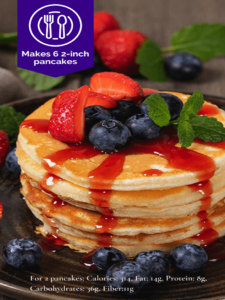Inflammation, simply put, is another word for stress.
Inflammation is the main culprit of autoimmune disease symptoms, including lupus. The best way to help relieve the symptoms of lupus is to “calm the fires” of inflammation. This can be achieved naturally through diet and lifestyle changes that can help slow the progression of lupus and quell the fires of inflammation, so you can live a more pain-free life.
Let’s begin with the start of your day and get you off on the right foot with a healthy breakfast! These Cassava flour pancakes will power the healing properties in your body against autoimmune disease and fuel your engine for the day with healthy energy and clean eating. Oh, and did I mention that they’re delicious?!
Coconut & Cassava Root Flour Pancakes Recipe.

Ingredients
- 1½ Tablespoons gelatin
- 3 Tablespoons boiling water
- 3/4 cup coconut flour
- 1/2 cup cassava flour
- Dash of cinnamon, nutmeg, or other spice of choice
- 1/2 cup coconut milk, warmed
- 2 Tablespoons honey and more to drizzle if desired
- 2 Tablespoons coconut oil, to cook with
- Your choice of berries or coconut yogurt as toppings
Instructions
- Follow the gelatin instructions by adding boiling water, stirring, and allow to cool.
- In a separate bowl, mix both the coconut and cassava flours, cinnamon, coconut milk, honey.
- Add 1½ Tablespoon of gelatin mixture together, whisking vigorously to combine and create a smooth texture. Keep this mixture warm by covering with a moist, hot towel, off to the side.
- Add 2 Tablespoons of coconut oil to a small non-stick pan over medium heat.
- Spoon in roughly 1/4 cup of the batter and let the pancake cook for 3-4 minutes before turning the pancake over slowly.
- Cook on the underside for 2-3 minutes until a nice golden crust forms, then place onto a paper towel to gently absorb any extra oil.
- Repeat until all the batter is gone. Should make a total of 6 pancakes.
- Serve drizzled with honey, coconut yogurt, and your favorite berries.
So, what is anti-inflammatory cassava flour?
Well, it just might be the answer to several of your dietary issues! Cassava flour comes from the cassava root. The cassava root is native to South America but is extensively cultivated in other tropical and subtropical regions in the world including India, Africa, and Indonesia.
Cassava is a calorie-rich vegetable filled with carbohydrates and key vitamins and minerals including vitamin C, niacin, riboflavin, and thiamine. Cassava also contains large amounts of manganese, phosphorus, calcium, potassium, iron, and a small amount of protein. In addition to being anti-inflammatory and gluten-free, cassava also aids in the digestive process. Cassava as a gut-friendly prebiotic is supported by recent research.
Is gluten-free cassava the perfect substitution for white flour?
Close! But not exactly. While cassava flour has developed a reputation for being the best mimicker of wheat flour when it comes to gluten-free flour choices, it’s lighter so baking with it can be a bit tricky. You can usually swap cassava flour for all-purpose white flour or wheat flour with a 1:1 ratio. Cassava flour is great for pancakes, tortillas and tortilla chips, baked yuca fries, and low-flour chocolate cake!
Due to its lack of gluten, cassava flour does not rise well when mixed with yeast, so it’s not the best substitute for baked goods that require yeast. Although sometimes used interchangeably, cassava flour and tapioca flour are not the same product. Unlike other gluten-free flour choices like coconut or almond flour, cassava flour is more neutral and milder with a subtle, nutty flavor. One of its other great features is that cassava flour is not gritty or grainy in texture, but rather soft and powdery – very similar to the consistency of traditional wheat flour.
How does cassava compare to the health quality of potatoes?
Similar to potatoes, cassava has very little fiber and high starch content. Because it’s low in sugar and contains so many other vitamins and nutrients, it is a great addition to your diet as a carbohydrate-rich side dish.
However, cassava flour should be used in moderation to avoid an insulin spike. If you’re following a Paleo-based, low carbohydrate, or low-sugar diet remember that cassava is a starchy tuber with a higher carbohydrate profile than you might assume. Per 100 grams, cassava has double the calories and carbohydrates as in sweet potatoes. So, simply put, just don’t eat cassava flour recipes at every meal. Cook with cassava flour in moderation.
* Our one-on-one customized functional consultation with our team focuses on identifying all the missing pieces to each individual’s health issues and creating a road map to fix them.
Schedule a Complimentary Discovery Consultation
Healthy Regards,
Dr. Tiffany Caplan & Dr. Brent Caplan
PS: Have fun exploring the creative and flavorful recipes in Dr. Caplan’s cookbook “ Friendly Recipes to Calm the Fires of Inflammation.” These delicious recipes are great support for lowering inflammation due to lupus or other autoimmune disease symptoms.
PPS: Self-care is so important, and an essential component of conquering autoimmune disease. This is why my wife; Tiffany and I created the “Simple Self Care for Autoimmunity” e-book. This guide provides 8 simple and effective ways to practice self-care you can start today! It’s our gift to you! Download it now at no cost!



I am concerned about SIBO and your suggestions for diet modifications and additions. Do you have any suggestions for incorporating SIBO diet issues into an anti-inflammatory diet regime? Thank you
Hi Rita! There are a few different SIBO dietary approaches out there. They should be utilized as a tool while working on eradicating SIBO and treating underlying factors that lead to the development of SIBO. I would recommend first focusing on that, and then after SIBO is eradicated, then incorporating anti-inflammatory foods into your life-long nutritional approach. I hope this helps. If you need any additional support in your health journey please feel free to reach out to us here: https://caplanhealthinstitute.com/consultation/